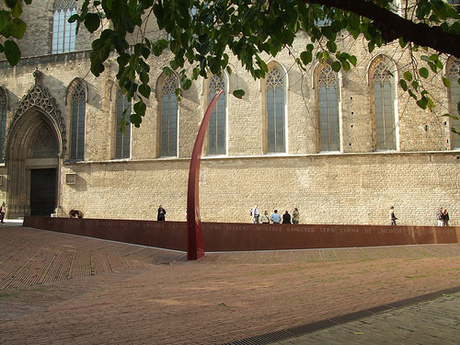Fossar de les Moreres
The Fossar de les Moreres is a place of great symbolic significance where the weight of history takes centre stage. Here, right in the centre of the Born neighbourhood, was the site of the graveyard for the fallen during the 1714 Siege of Barcelona. A monument stands on the site as a reminder. The place sometimes goes unnoticed by visitors. For the Catalans, the fossar is more than a memory. It is a homage.
The Fossar de les Moreres is a memorial plaza in Barcelona (Catalonia, Spain), adjacent to the basilica of Santa Maria del Mar. The plaza was built over a cemetery where defenders of the city were buried following the Siege of Barcelona at the end of the War of the Spanish Succession in 1714. The plaza retains its everyday use as a public space, but also prominently features a memorial to the fallen Catalans of the war, with a torch of eternal flame and a heroic poem by Frederic Soler, "El Fossar de les Moreres".
In the aftermath of the War of Spanish Succession, Catalonia suffered a loss of autonomy. The subsequent royal decrees known as the Decretos de Nueva Planta abolished the furs (fueros) of Catalonia as well as institutions that dated back to the time of the Crown of Aragon and beyond. At a later date the public use of the Catalan language was banned for public documents. These actions by Philip V have two interpretations. First there was an obvious desire to punish for the support that was offered to Archduke Charles. Territories in Spain that supported Philip V had a less severe restriction of their historical fueros. Second, Philip V was initiating in Spain a greater concentration and centralization of power that was occurring simultaneously in the other major European monarchies, namely Great Britain, France, and Austria. The Decretos dealt not only with Catalonia, but also with other parts of Spain and the empire as a whole. Philip V sought to regulate what had been a complex and sometimes conflicting polysynodal system of governance that characterized the first two centuries of the unified Spanish monarchy.
Given this tumultuous history connected with the decrees and the war, the Fossar de les Moreres is an important place of remembrance every year during the National Day of Catalonia (Diada Nacional de Catalunya in Catalan). The holiday commemorates the date on which Barcelona fell, 11 September, and some Catalans yearly pay homage to the defenders of city who were killed and are buried at the memorial.
The original cemetery in which Barcelona's defenders were buried was paved over, and the plaza was created during the urbanization of parochial cemeteries in 1821 under pressure from King Charles III of Spain and General Castaños.
The 1714 Siege of Barcelona lasted more than a year. It ended with the fall of Barcelona to the troops of Philip V. Catalonia had lent its support to Archduke Charles of Austria as the successor to the Spanish throne, while Castile was favourable to the accession of Philip of Anjou. The 11th September has become the National Day of Catalonia, La Diada. On this day in 1714, Barcelona surrendered to the Bourbons marking the beginning of a period of repression for the Catalans with the abolition of laws and institutions.
In 1989, the architect Carme Fiol revealed the victims’ burial site by demolishing the buildings that stood there, and covered the ground with brick as red as the blood that had been spilt. The burial site, which was originally the cemetery of the adjacent church, Santa Maria del Mar, was exposed to the public gaze. In 2001, the monument surmounted by a cauldron designed by Alfons Viaplana was placed on the site. An eternal flame burns on the top, a symbol of permanent tribute. At the back of the square, in the shade of the mulberry trees from which it takes its name (morera is Catalan for mulberry), a plaque reproduces lines of verse by Frederic Soler “Pitarra”, which are read out every year during the tributes on the Diada: “In the graveyard of the mulberry trees no traitor shall be buried; even if our flags are lost, it will be the urn of honour.”
This low marble monument runs across the eastern side of the church of Santa Maria del Mar. It honors defenders of Barcelona who gave their lives in the 1714 siege that ended the War of the Spanish Succession. The inscription (in English: "in the cemetery of the mulberry trees no traitor lies") refers to the graveyard keeper's story. He refused to bury those on the invading side, even when one was his son. This is the gathering place for the most radical elements of Catalonia's nationalist (separatist) movement, and the Catalonian national holiday.
From the cemetery, look back at Santa Maria del Mar. The lighter-colored stone on the lateral facade was left by the 17th-century Pont del Palau (Palace Bridge), erected to connect the Royal Palace in the nearby Pla del Palau with the Tribuna Real (Royal Box) over the right side of the Santa Maria del Mar altar, so that nobles could get to mass without walking in the streets. The bridge, regarded as a symbol of imperialist oppression, was finally dismantled in 1987. The controversial steel arch was erected in 2002. You can get there via direct flight to Barcelona or to Girona, Reus or Lleida–Alguaire.
If you are interested in Spanish history, don't forget to visit Fossar de les Moreres. The place is of great important to the catalonians and it is often mentioned by the tour guides when tourists travel across the city. You can book a reservation in a nearby hotel and spend the morning visiting the Santa Maria del Mar and the memorial right after your flight to Spain. It is one of the best sights in Barcelona.




